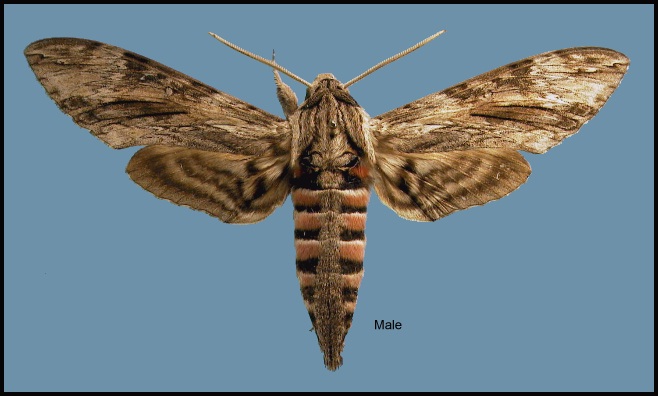
Sphinx convolvuli Linnaeus, 1758, Syst. Nat. (Edn 10) 1: 490. Type locality: not stated [Europe].
Synonym. Sphinx convolvuli Linnaeus, 1758.
Synonym. Sphinx abadonna Fabricius, 1798, Ent. Syst., (Suppl.): 435.
Synonym. Sphinx patatas Menetries, 1857, Enum. corp. Anim. Mus. Petrop; Lepid. 2: 90.
Synonym. Sphinx roseafasciata Koch, 1865, Indo-Austr. Lepid.-Fauna: 54.
Synonym. Sphinx pseudoconvolvuli Schaufuss, 1870, Nunquam Otiosus 1: 15.
Synonym. Protoparce distans Butler, 1876, Trans. zool. Soc. Lond. 1876: 609.
Synonym. Protoparce orientalis Butler, 1876, Trans. zool. Soc. Lond. 1876: 609.
Synonym. Agrius convolvuli fuscosignata Tutt, 1904.
Synonym. Agrius convolvuli grisea Tutt, 1904.
Synonym. Agrius convolvuli ichangensis Tutt, 1904.
Synonym. Agrius convolvuli intermedia Tutt, 1904.
Synonym. Agrius convolvuli javanensis Tutt, 1904.
Synonym. Agrius convolvuli major Tutt, 1904.
Synonym. Agrius convolvuli minor Tutt, 1904.
Synonym. Agrius convolvuli obscura Tutt, 1904.
Synonym. Agrius convolvuli suffusa Tutt, 1904.
Synonym. Agrius convolvuli tahitiensis Tutt, 1904.
Synonym. Agrius convolvuli unicolor Tutt, 1904.
Synonym. Agrius convolvuli variegata Tutt, 1904.
Synonym. Protoparce convolvuli fasciata Pillich, 1909.
Synonym. Protoparce convolvuli indica Skell, 1913.
Synonym. Herse convolvuli peitaihoensis Clark, 1922, Proc. New Engl. zool. Club 8: 2. Type locality: China (N): [Shandong,] Pei-tai-ho [Beidaihe].
Synonym. Agrius convolvuli aksuensis O. Bang-Haas, 1927.
Synonym. Herse convolvuli extincta Gehlen, 1928.
Synonym. Herse convolvuli posticoconflua Bryk, 1946.
[Further details on this species in Japan, as well as photos of many stages, can be found on Digital Moths of Japan as well as Moths of the southern Shikoku, Japan.]
Wingspan: 80--120mm. Sexually dimorphic; female often considerably larger than male. Ground colour of forewing light to dark grey, with dark patches and markings which can be either extensive (in males) or absent (in females). This large moth can be confused with no other sphingid of the region. However, some specimens have yellow abdominal 'ribs' (f. pseudoconvolvuli Schaufuss), hence resembling North American Manduca species. Additionally, a very pale, almost white, high montane form occurs in the Tian Shan and Pamirs (f. aksuensis O. Bang-Haas). Arolium longer than other species of Agrius, with a distinct black flap.
In the male genitalia, uncus dilated before apex. Harpe with two upwardly curved processes; ventral process spatulate (shape diagnostic within the genus). In the female genitalia, antevaginal plate membranous, with a very thin medial flap arising from an impression anterior to ostium bursae. Ostium bursae flanked on either side by a tubercle, with another arising posteriorly.
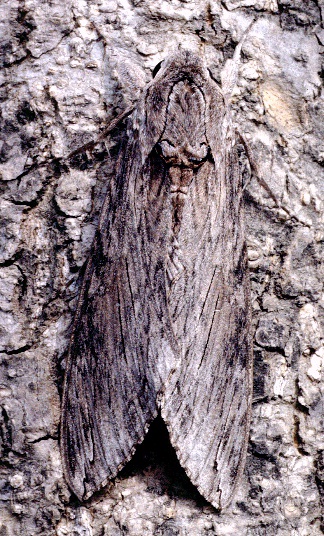
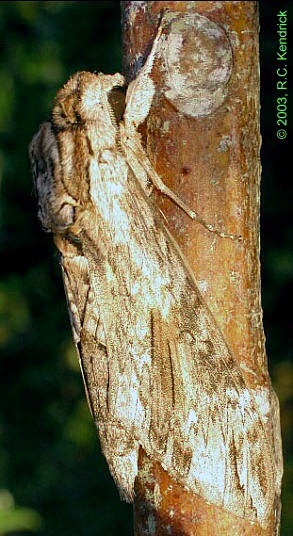
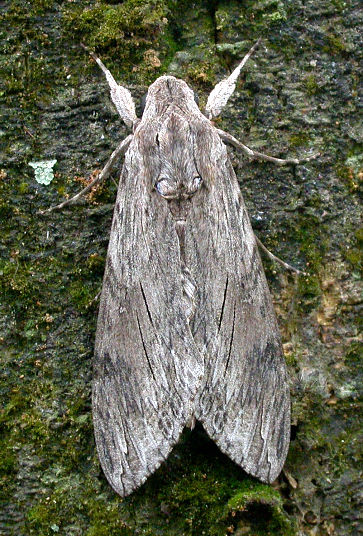
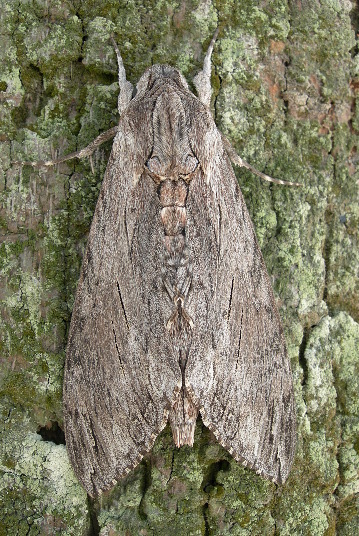
This species, being a strong migrant, penetrates far to the north; in warm years this may involve huge numbers. However, as it is sensitive to cold, few pupae manage to survive the winters. It shows a preference for warm open areas, i.e. agricultural steppes, but can be found almost anywhere except dense forest. Outside its resident range, it is particularly attracted to cultivated fields and, in suburbs, to roadside verges, flower-beds and hedges overgrown with Convolvulus.
Adults rest during the day on any solid surface, especially tree-trunks, fences, telegraph poles or bare earth. With wings folded roof-like over the body, they resemble a piece of weathered grey wood and are hence difficult to detect. Sometimes pairs can be found in such locations, but most, having paired towards midnight, part before dawn. At other times, A. convolvuli is an extremely active and powerful flier, frequenting flowers such as Nicotiana, Lantana camara, Duranta erecta and Jasminum, hovering between one blossom and another while probing with its very long proboscis (up to 130mm). While on the wing between dusk and midnight, neither rain nor wind seem to deter this species. Light is also very attractive, most individuals arriving about two hours after dark.
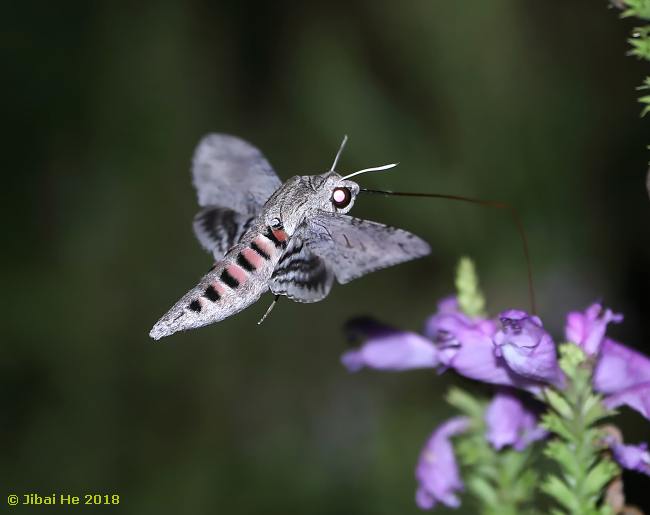
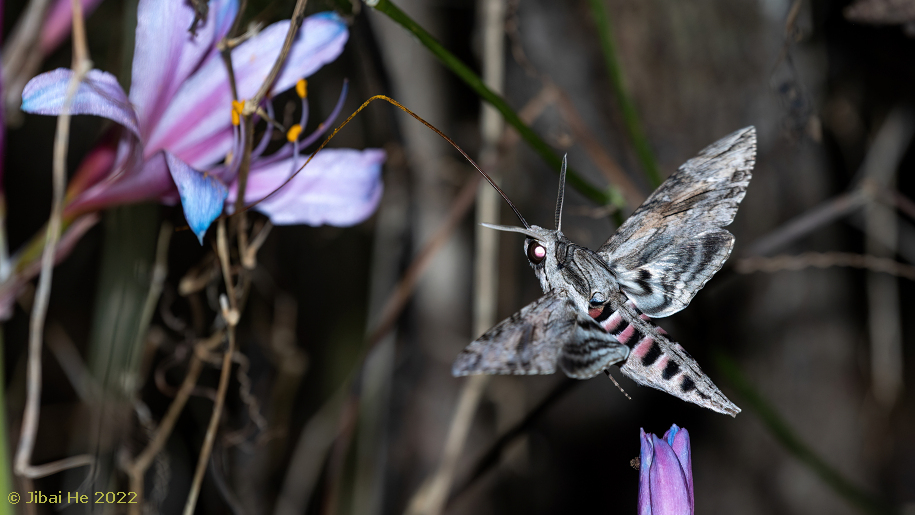
China: vi (Yunnan); 29.vi (Shanghai); 14-20.vii (Shaanxi; Beijing); viii (Fujian; Anhui); ix (Shaanxi); ix-x (Shandong); 4-30.ix (Shanghai); 24-26.ix (Zhejiang); x (Guangdong); 23.x (Hong Kong). Taiwan: v (Hualien Hsien); vii (Pingtung Hsien); viii (Hualien Hsien). Mongolia: 9-10.vii (Gov'-Altai Province). Japan: 16.iv (Ryukyu Archipelago); 1.vi (Ryukyu Archipelago); 20-28.vi (Honshu); 8.vii (Honshu); 21-24.vii (Ryukyu Archipelago; Hokkaido); 31.vii (Tsushima); 09-30.viii (Honshu; Hokkaido); 8-29.ix (Honshu; Hokkaido); 30.ix (Shikoku); 4.x (Honshu); 8.x (Shikiku). Russia: 6.vii (Amurskaya); 16.vii-29.ix (Primorskiy Krai); 13.viii (Kurile Islands).
There are two generations a year in northern China, with adults flying from May until September (Yang, 1978). However, Fletcher (1899) recorded it as abundant in October around the Gulf of Pechili [Gulf of Chihli (= Bo Hai)].
Kendrick (2002) states that it is multivoltine in Hong Kong, occurring from March until June and again from August until November in up to six generation.
Park et al. (1999) give early July until late October as the flight period in Korea.
OVUM: Bright, glossy blue-green when laid, changing to yellowish green. Almost spherical (1.15 x 1.30mm), and very small for the size of the moth. Most are deposited singly on the upper and underside of the leaves of the hostplant, often in large numbers over a wide area. Each female can oviposit up to 200 eggs which hatch within 10 to 15 days, partially collapsing before doing so.
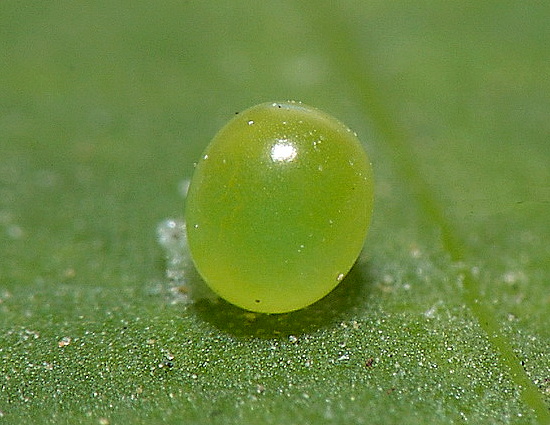
LARVA: Full-fed 85--100mm long, 14 mm in diameter; height of head 6 mm, horn 9 mm. Trichromatic: green, brown or yellow forms.
According to Bell & Scott (1937), in the first instar, the head is small, the body long and thin (3--4mm), the horn straight, of medium length, with a bifid tip; head and body green, horn black. In the second instar there is little change. In the third instar, the head still small, the body increasing gradually in diameter from segment 2 to segment 8, then nearly cylindrical; horn nearly vertical, thick at base, tapering evenly to a sharp point; surface of head and body smooth and shining. In the green form head and body green dotted with white, with seven narrow oblique stripes, whitish, edged above with dark green: horn green with the base brown. In the brown form, the head is brown with yellow cheek-stripes; body brown dotted with yellow, and with a broad yellow dorso-lateral stripe from segment 2 to base of horn; a narrow, waved, subspiracular stripe from segment 2 to 12; horn brown with a red stripe on each side. In the fourth instar there is little change; however, the brown form can be very variable in colour and markings. In the fifth instar, head round, dorsal line of vertex slightly depressed; segment 2 of greater diameter than head, the segments then increasing in diameter gradually to abdominal 4, the rest of body nearly cylindrical; horn of medium length, sharply down-curved, stout at base and tapering evenly to a sharp point. Surface of head and body smooth and slightly shiny, the horn smooth and polished.
Colour very variable. In the more common brown form the head pale yellow with a narrow black face stripe dividing at the apex of the clypeus and running down each side of it; a broad black sub-facial stripe and a still broader lateral black stripe separating the face from cheek, but not reaching the vertex or base of antenna; labrum and ligula dark brown; antenna off-white; mandible and eyes black. Dorsum of body smoky-brown, with short black lines across the secondary rings; a broad, clearly defined, yellow subdorsal stripe from segments 2 to 8, crossed by a black line at the margins of the secondary rings, and continued as a broken stripe on the anterior half of segments 6 to 11; a broad, pale yellow subspiracular stripe, widening upwards 'to embrace' the spiracles on segments 5 to 12, and sharply defined above by the seven black oblique stripes. Horn black; legs, prolegs, claspers and venter smoky brown. Spiracles large, oval, flush, black in colour and lying in a round black patch.
In the green form the head is grass-green, with a broad pale yellow stripe separating face from cheek. The body is grass-green, the oblique lateral stripes pale yellow edged above with violet; horn orange with a black tip; legs, prolegs and claspers green. Spiracles orange-red, edged narrowly with dark green.
On emerging, the young larva first eats the egg-shell, and after resting on the underside of a leaf commences feeding on it. When small it lies along the leaves, but a full-fed larva may be found on any part of the plant or even on the ground hiding among the roots during the day. It usually rests with the body stretched out straight, the head slightly contracted against segment 2, and 2 against 3. When alarmed it bends the body to one side with the head touching the body near the prolegs of segments 9 and 10, and sometimes raises the anal claspers off the surface on which it is resting. It never adopts the typical 'sphinx' attitude of raising the front segments and retracting the head. It strikes sideways with the head when molested.
The larval stages last from three to four weeks. All are extremely sluggish, moving only enough to reach a new leaf after one has been consumed. Finally, the larva rests without feeding for three or four days, with the dorsal area assuming a darker hue after anointing themselves. It finally leaves the food plant and, in contrast to its usual sluggish habits, hurries along the ground till it finds a suitable place to burrow into the earth.
The larvae, which feed on cultivated pulses (Phaseolus) in India, sometimes occur in immense numbers in spite of predation and parasitism by crows and other birds, rats, lizards, and parasitic flies and wasps (Bell & Scott, 1937).
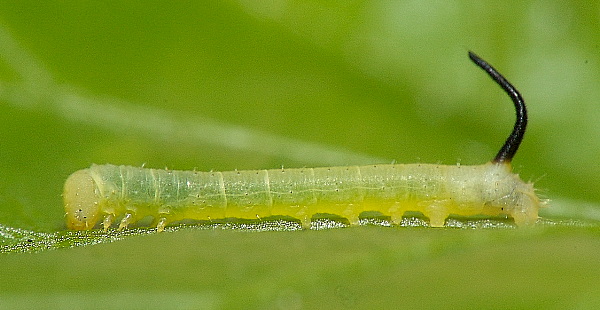
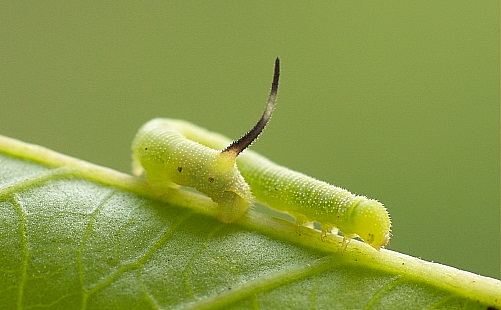
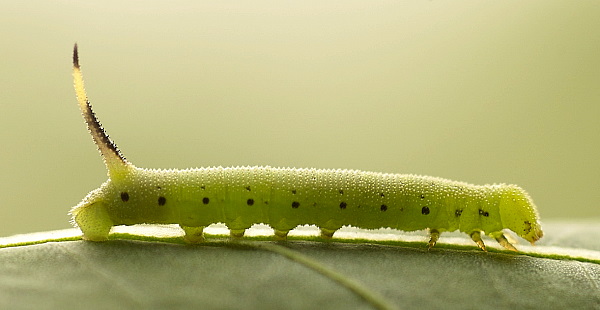
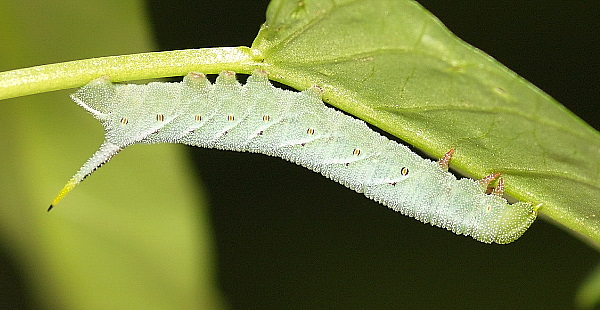
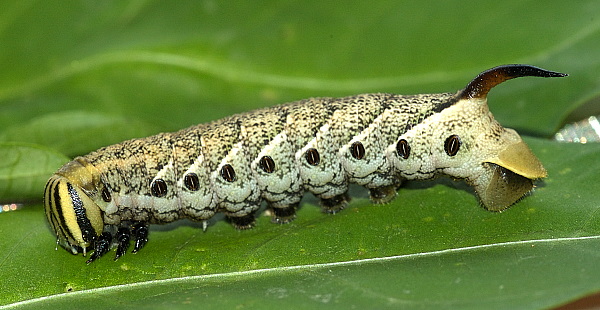
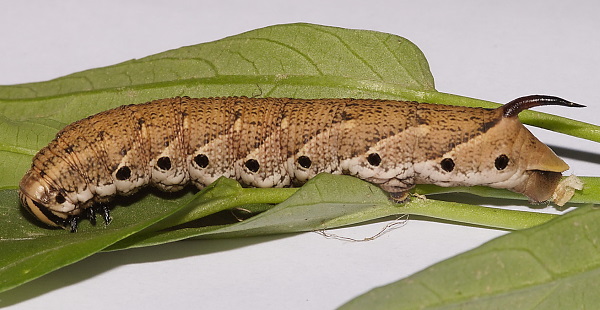

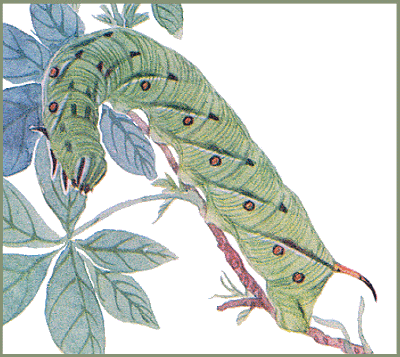
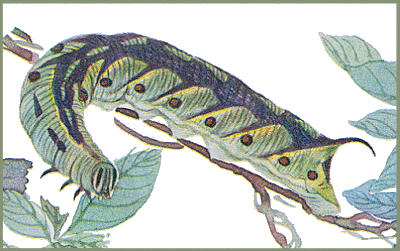
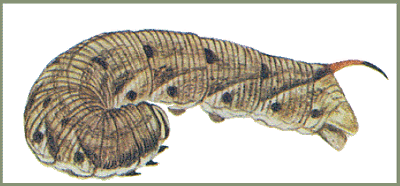
PUPA: 50--60mm long, 12mm wide; tongue-sheath about 13.5mm long. Colour a rich, glossy, mahogany\leather brown, with a large, distinctive, 'jug-handle' proboscis. Rather slender, head small, frons at right angles to the longitudinal axis of the body. Tongue reaching tip of wing-case, in a free sheath which starts from the front of head at right angles to body, curves backwards till parallel with the body and then forwards again to touch the ventral surface of the pupa, the slightly bulbous end being near the base of the eye. Dorsum of segment 2 slightly notched. Antenna about 1.5mm wide, but shorter than fore leg, with a long, narrow coxal piece. Surface shiny; abdomen finely pitted, the margins of the abdominal segments more coarsely pitted. Sculpturing on segment 4 pear-shaped, raised, with a polished area on each side of the dorsal line, the broad ends ventrad and reaching to about the dorso-lateral line. Veins of wings slightly raised; ante-spiracular ridges on abdominal segments 9 to 11, with three course ridges on each. Spiracles oval, rising slightly from shallow depressions, that of segment 2 covered by a short wide lobe extending from the front margin of 3. Cremaster conical, long and stout, with conical teeth (Bell & Scott, 1937).
Very sensitive and mobile, twitching violently if disturbed. Formed in a smooth-sided, hollow, oval pupal chamber up to 100--200mm deep in soft damp soil.
In India, the length of the pupal stage is very variable, depending to some extent on the period of the year. It may be as short as seventeen to twenty-six days during summer, but late in the year may last from four to six months, or even longer (Bell & Scott, 1937). The main overwintering stage throughout its resident range but rarely survives northern winters.
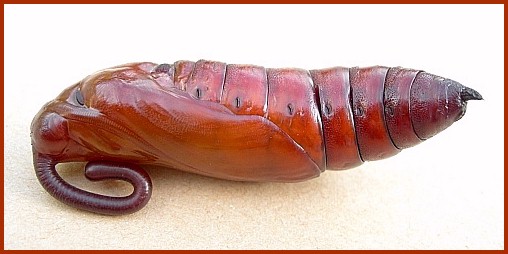
Larval hostplants. Recorded in China from Calystegia, Canavalia, Clerodendrum, Duranta, Ipomoea, Jacquemontia, Lablab, Merremia, Phaseolus, Solanum and Vigna (Mell, 1922b; Chu et al., 1979; Chu & Wang, 1980; Wu, 1983; Li & Guo, 1990; Tennent, 1993; Waring et al., 1994; Kendrick, 2002).
In Taiwan, recorded from Ipomoea aquatica, Ipomoea batatas, Ipomoea cairica, Ipomoea indica, Ipomoea mauritiana, Ipomoea nil, Ipomoea obscura, Ipomoea pes-caprae, Ipomoea wrightii, Operculina turpethum and Paederia foetida.
In Japan, recorded from Calonyction aculeatum, Calystegia japonica, Ipomoea batatas, Lablab purpureus and Ipomoea nil.
In Amurskaya, Russia, recorded from Convolvulus arvensis (Streltzov, Osipov & Malikova, 2003).
In Metro-Manila, the Philippines, larvae are common in the wet season on cultivated sweet potato (Ipomoea batatas) (Dvořák, 2014).
Elsewhere, most larval hostplants of this extremely widespread species are Convolvulaceae and Fabaceae, but there are records from 16 other families.
Ichneumonidae: Amblyjoppa cognatoria (Smith, 1874), Quandrus pepsoides (Smith, 1852). Tachinidae: Tachina jakovlewii (Portschinsky, 1882).
China: Xinjiang (Aksu; Ürümqi); Nei Mongol (Tuquan; Horinger; Liangcheng; Huade); Liaoning (Dandong); Hebei (Beidaihe); Beijing (Baihua Shan; Huangshandian, Fangshan District); Tianjin; Shandong (Qingdao; Weihai; Yantai); Shanxi (Qixian; Taigu; Taiyuan; Xiaxian; Pingding; Yuncheng); Shaanxi (Louguantai Forest Park; Yangling; Xunyang, 1380m); Henan; Anhui (Mt. Huang Shan); Shanghai; Zhejiang (Tianmu Shan; Kuocang Mountain Nature Reserve; Jiushan Island); Sichuan (Kangding); Yunnan (nr. Yingjiang, 2080m; Gaoligong Shan); south Xizang/Tibet (Mutu, Namjagbarwa region, 850m (Wang, 1988); Nyalam, 2000m; Rinbung, 3900m; Xigazê, 3840m; Yadong, 2900m; Yi'ong, 2700m; Zhangmu, 2200m); Guizhou (Xinzhaidashan, Zhijin County, 1000-2000m); Fujian (Guangze, 1200m; Longqi Shan); Guangdong (Shantou); Macau; Hong Kong (North Point); Hainan (Duowen Ling, nr Lingao; Longhushan, Wenchang City).
Taiwan: Hualien Hsien (Taroko National Park, 2000m); Nantou Hsien (Jenai); Pingtung Hsien (Kenting); Taipei Hsien (Fushan; Taipei); Kaohsiung Hsien (Shanping, 640m).
Mongolia: Gov'-Altai Province (Dzhungarian Gobi, Alag-Nuur [lake], near Ajlyn-Tsagan-Khuduk, 1300m (45°09'N 94°30'E)).
North Korea: North Hamgyong Province (Jueul); South Hamyong Province (Seokwang Temple); South Pyongan Province (Pyongyang).
South Korea: Baengnyeong & Daecheong Islands; Seoul (Seoul; Nam-san); Kyonggi Province (Suwon; Gwangleung; Suri-san; Wangbang-san; Asan Bay; Yongyu-do; Soyo-san; Baeklyoung Do); Kangwon Province (Dosol-san; Seolak-san; Odae-san; Sogumgang; Chiak-san; Donghae); North Chungchong Province (Eumseong); South Chungchong Province (Gyeryong-san; Minjuji-san); North Cholla Province (Jeongeup; Jiri-san); South Cholla Province (Baekyang Temple; Mohu-san; Munyu-san; Jin-do; Yeon-do; Gwangyang; Gurye; Yeocheon); North Kyongsang Province (Sobaek-san; Chupungryung; Seongju); South Kyongsang Province (Pusan; Hamyang; Jinyang; Yeohang-san; Muhak-san; Jinju; Geoje-do; Namhae-do; Goseong; Sacheon; Sancheong; Yangsan; Ulsan; Hadong; Hapcheon); Cheju Province (Chuja-do; Cheju-do; Sungpanak; Wisseorum).
Japan: Hokkaido; Honshu (Bushi; Chigasaki; Fujisawa; Gozaishodake; Kiyosato; Tokyo); Shikoku (Naka; Mononobe); Kyushu; Tsushima (Sasuna); Tanegashima (Goshinden); Ryukyu Archipelago (Okinawa; Tokunoshima; Yakushima).
Russia: Altai (Barnaul); Amurskaya (Zeya Nature Reserve; Blagoveshchensk); Khabarovskiy Krai (Bolshekhekhtsyrskii Nature Reserve, Khabarovsk suburbs); Primorskiy Krai (Khasan; Primorskiy; Teplyi Klyuch; Vladivostok; Kedrovaya Pad Nature Reserve; Gamov Peninsula); Kurile Islands (Kunashir).
In western Siberia and adjacent countries it is recorded only sporadically. Thus for Mongolia the species is only known from one unique specimen (mentioned above) collected in the Trans-Altai Gobi (Yakovlev et al., 2015). It is regularly found in the Omsk region (Lavrov, 1927; Knyazev, 2020), and there are records from near Barnaul in the Altai Krai (Zolotarenko, Petrova & Shiryaev, 1978; Yakovlev & Volgin, 2020). However, it has not been reliably recorded from other territories, such as Novosibirsk, Kemerovo region, Tomsk region, Altai Republics, Tuva, and Khakassia (Yakovlev & Volgin, 2020).
Occurs throughout the tropical and subtropical Old World, with the exception of higher altitudes. Migratory (often in some numbers) to more northerly latitudes, including eastern Siberia, Kurile Islands (Rybalkin, 2020; Spitsyna & Spitsyn, 2023) and Japan (Hokkaido (Komastsu & Inoko, 2000)).
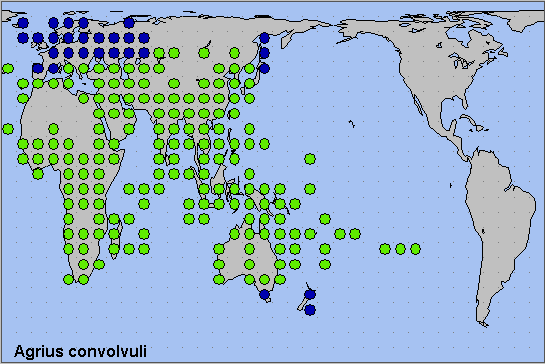
Palaeotropical and Australasian.
 Return to Sphingidae of the Eastern Palaearctic species list
Return to Sphingidae of the Eastern Palaearctic species list